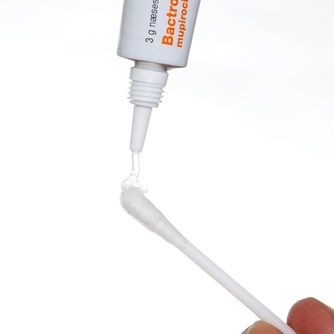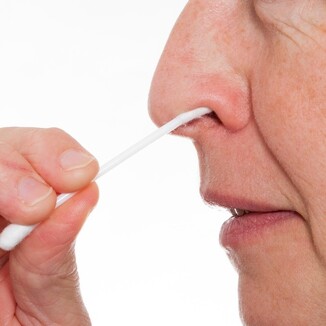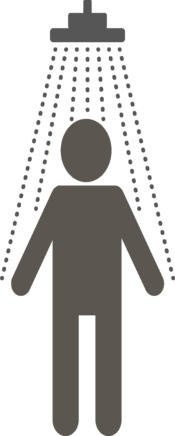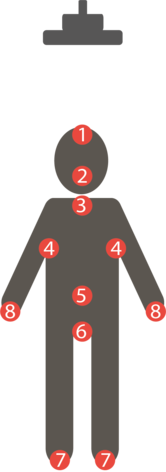Treatment of MRSA carrier condition
You have been tested for MRSA (methicillin-resistant staphylococci) and found to be an MRSA carrier. A healthy person has little risk of becoming seriously ill with MRSA, but the bacteria can in some cases lead to troublesome infections such as boils and sores.
People with health problems may be at risk of serious infections that need prolonged and complicated treatment. To get rid of the bacteria you will need appropriate treatment, and it is of great importance that you undergo the prescribed course of treatment in order to make sure that the bacteria have been removed.
Each day you must
- remove the bacteria from your nose
- remove the bacteria from skin and hair
- remove the bacteria from your home.
On the following pages you will find the relevant instructions.
After treatment a check-up may prove necessary following consultation with the MRSA-team.
-
You have been tested for MRSA (methicillin-resistant staphylococci) and found to be an MRSA carrier. A healthy person has little risk of becoming seriously ill with MRSA, but the bacteria can in some cases lead to troublesome infections such as boils and sores.
People with health problems may be at risk of serious infections that need prolonged and complicated treatment. To get rid of the bacteria you will need appropriate treatment, and it is of great importance that you undergo the prescribed course of treatment in order to make sure that the bacteria have been removed.
Each day you must
- remove the bacteria from your nose
- remove the bacteria from skin and hair
- remove the bacteria from your home.
On the following pages you will find the relevant instructions.
After treatment a check-up may prove necessary following consultation with the MRSA-team.
-
If you have questions, you are welcome to contact us.
The Unit of Infection Hygiene
The MRSA-team
Telephone: 97 66 50 00
Monday – Thursday 8.00 – 15.00
Friday 8.00 – 14.30
Facts about MRSA
MRSA is a bacterium (staphylococcus) which is resistant to the most frequently used types of antibiotics. The bacteria may occur on the skin or in the nose without causing signs of infection. This is called carrier condition.
Transmission of MRSA
MRSA is transmitted by direct contact with a person who is an MRSA carrier, primarily someone in your family. Touching hands and kissing/hugging transmit contagion with MRSA. In many cases there will be several members of a family who are MRSA carriers. For that reason, The Danish Health Authority recommends that all members of a family undergo treatment at the same time.
Hands are the main route of contagion with MRSA. Transmission happens when we touch one another or objects in our surroundings. Thorough and frequent handwashing is the primary way of pre-venting transmission of the bacteria. Good hand hygiene implies using soap and water and disposable towels or a towel that is used by one person only. (So, each family member should have his or her designated towel). When the hands are clean and dry, an alcohol-based hand rub with glycerol may be applied. This is the best way of removing MRSA.
Staphylococci are extremely hardy and can survive for months on skin scales found in bedding and in your surroundings. So, there is a risk of contagion from surroundings, but the risk of contagion from shopping, going to work or to school is minimal, and so is the risk of bacteria being transmitted in swimming baths, fitness clubs and sports centers. The risk involved in social contacts such as visits to friends and relations is also minimal.
-
Nasal ointment Bactroban® is used to remove MRSA-bacteria from nose and throat.
The ointment must be applied to both nostrils twice a day, that is morning and evening.
-
- Before you apply the nasal ointment, wash your hands thoroughly with soap and water.
- Place an amount of ointment – the size of a big match-tip – on one side of a Q-Tip.
- Apply the ointment to the first cm of one nostril and make sure that it is spread evenly.
- Turn the Q-Tip and place a similar amount of ointment on it and apply it to the other nostril. Dispose of the Q-Tip.
- Now gently press the sides of your nostrils together to spread the ointment in your nose.
- Wash your hands.
-
Bactroban® is for use in the nose only and must not be combined with other nasal ointments.
Bactroban® should not be used if you are allergic to any of its ingredients. Check the information leaflet for further side effects.
If more members of your household are undergoing treatment, each person should have his or her own tube of ointment, and we recommend synchronous treatment.
-
Once each day you must take a shower washing body and hair with chlorhexidine soap 4 in order to remove MRSA bacteria from the surface of your skin.
Do not use other kinds of soap and shampoo while you are undergoing treatment.
-
- Rinse your body and hair thoroughly.
- Turn off the water.
- Wash your hair with the soap. Avoid getting soap into eyes and ears. If soap gets in your eyes, rinse with water for several minutes.
- Pour an adequate amount of soap in your hand or on to a wetted, disposable face cloth, which you dispose of after washing.
- Begin by washing your face avoiding your eyes. Clean the areas around nose and mouth especially carefully. Next, wash your armpits and then the rest of your body paying attention to skin folds, navel, genitals, groins and anus.
- Avoid applying the soap to mucous membranes and body cavities, e.g. your mouth.
- Rinse the soap off with plenty of water.
- You may now use hair conditioner or treatment,
- Dry hair and body with a clean towel beginning with face and hair.
- Put on clean clothes.
- Towels need to be washed at highest possible temperature.
After your shower you may use deodorant, after-shave and moisturizing cream.
-
You should use a recommended skin moisturizing cream
To prevent dry skin caused by the 4% chlorhexidine soap we recommend that you use a rich moisturizing cream after your shower. Some creams reduce the effect of the antibacterial soap. You can find a list of recommended creams on the website of Statens Serum Institut (SSI), www.SSI.dk. Look for ‘hudplejeprodukter’.
Do not wear jewelry while you are undergoing treatment
Jewelry can make it difficult to disinfect all areas of your body, so do not wear for example rings on your fingers, earrings and body piercing jewelry for the duration of your treatment.
Change toothbrushes
On the second day of your treatment, you must scald your toothbrush or replace it with a new one.
-
Hygiene directions
- Make sure that each member of the household has his or her designated towel and face cloth, so bacteria are not transmitted from one person to another. Underwear and towels should be changed daily.
- Make sure that each member of the household has fresh bed linen on the second day of treatment and when the treatment has been completed.
- Bed clothes, towels, underwear, tea towels and dish cloths must be washed at 90 degrees after use.
- If possible, duvets and pillows should be washed at the end of treatment.
- Clean all horizontal surfaces with soap and water.
- Vacuum clean your home on the second day of treatment and when the treatment has been completed. Also vacuum clean mattresses and upholstered furniture thoroughly.
- Each day clean places that are touched frequently, such as handles, water taps, toilet seats, flush buttons and mobile telephones/electronic equipment.
-
Chlorhexidine 4% soap is an antiseptic and disinfectant liquid soap used to eliminate bacteria on skin surfaces. No perfume and no preservatives have been added.
Side effects
Skin irritation: in rare cases, the chlorhexidine in the disinfectant soap can cause an allergic reaction. If your treatment leads to severe irritation of the skin such as rash or itching, stop using the soap and contact the MRSA-team. Chlorhexidine soap can be used during pregnancy and while breastfeeding.
-
Bactroban 2% is a nasal ointment that contains a narrow spectrum antibiotic (Mupirocin) used to remove staphylococci from nose/throat.
Side effects
- There may be burning or stinging in the nose
- An allergic reaction very rarely occurs. Do not use the ointment if you are allergic to any of the ingredients listed in the information pamphlet.
The ointment can be used during pregnancy and while breastfeeding.
-
Contact us in case of adverse effects or inconveniences.
In case of adverse effects, call your contact nurse at the Unit of Infection Hygiene.
If you need urgent assistance outside the opening hours of the Unit of Infection Hygiene, you have to call the Emergency Medical Service.
The Unit of Infection Hygiene
The MRSA-team
Telephone: 97 66 50 00
Monday – Thursday 8.00 – 15.00
Friday 8.00 – 14.30
-
1.
Place an amount of ointment – the size of a big match tip _ on one side of a Q-Tip

2.
Apply the ointment to the first cm of one nostril and make sure that is is spread evenly

3.
Turn the Q-Tip and place a similar amount of ointment on it and apply it to the other nostril. Dispose of the Q-Tip.

3.
Now gently press the sides of your nostrils together to spread the ointment on your nose.

-
1.
Rinse your body thoroughly.

2.
Turn off the water. Begin by washing your hair with the soap and then your face avoiding your eyes. Clean the areas around nose and mouth especially carefully. Next, wash your armpits and then the rest of your body paying attention to skin folds, navel, genitals, groins and anus.

3.
Rinse off the soap with plenty of water.



